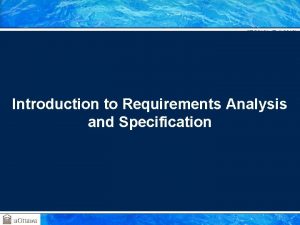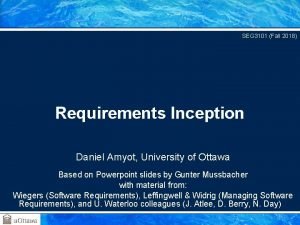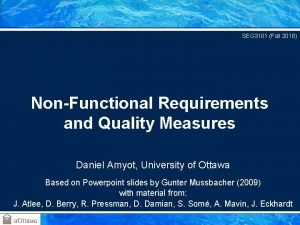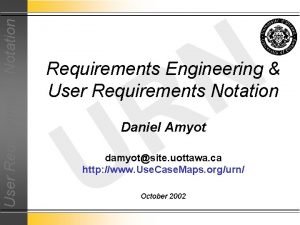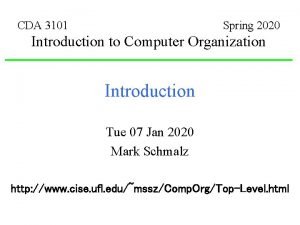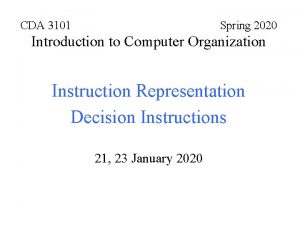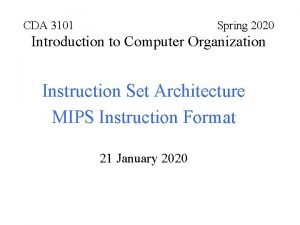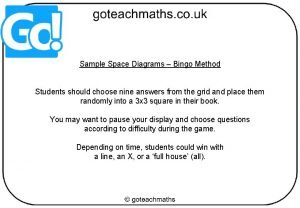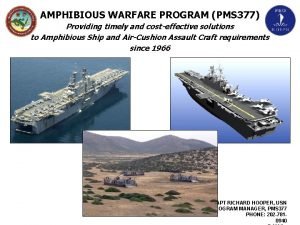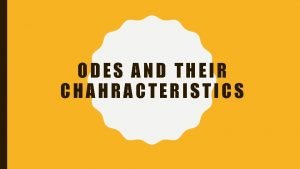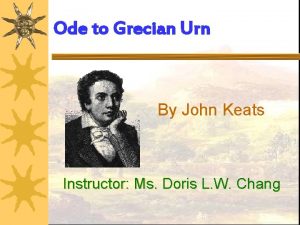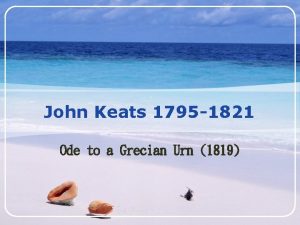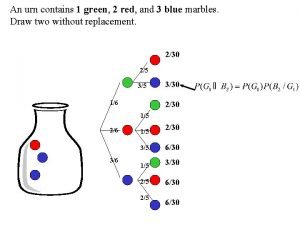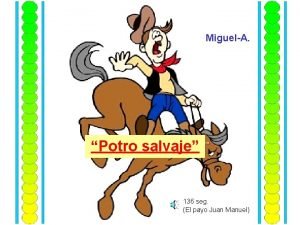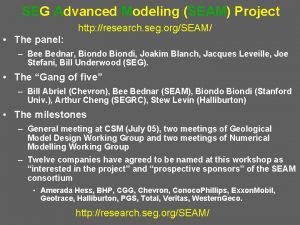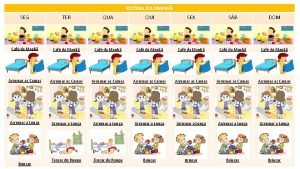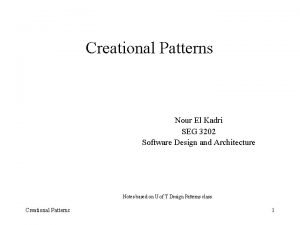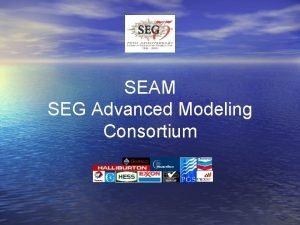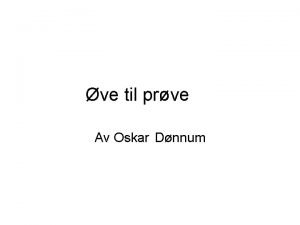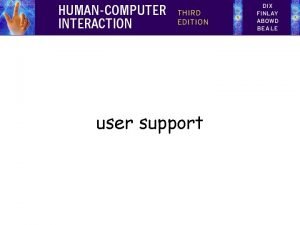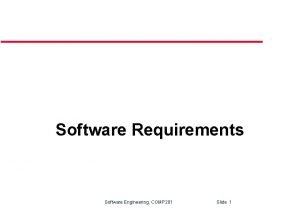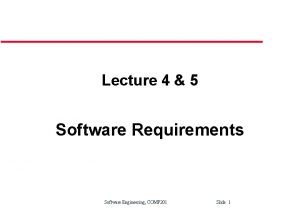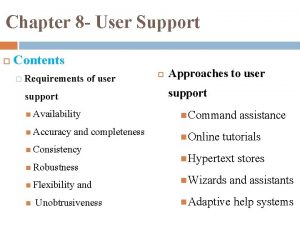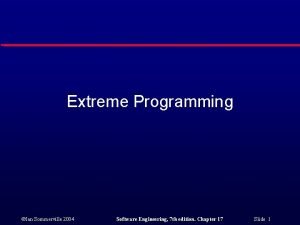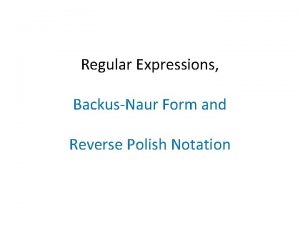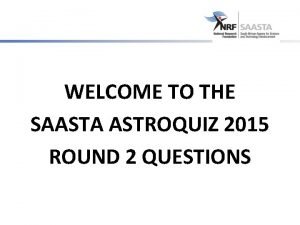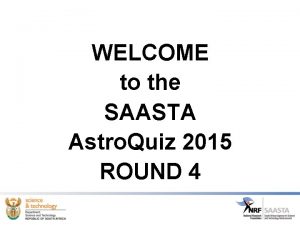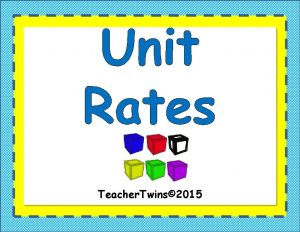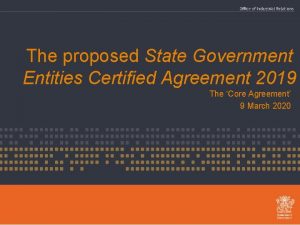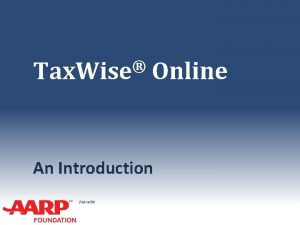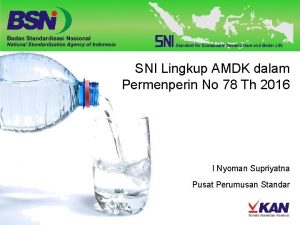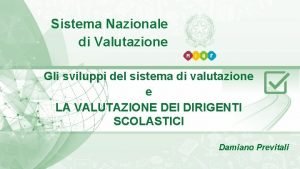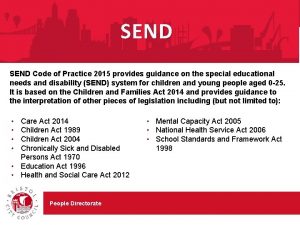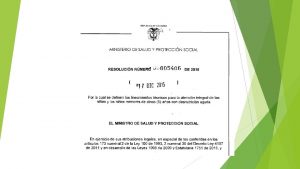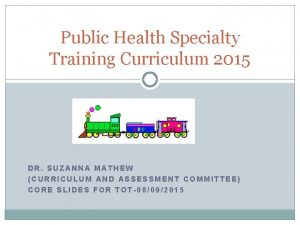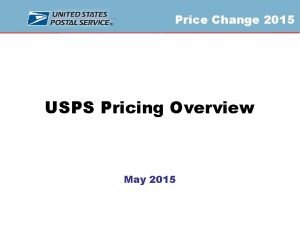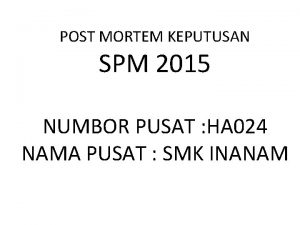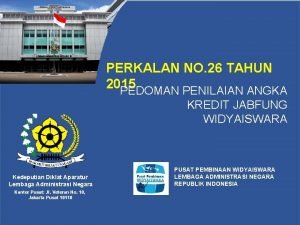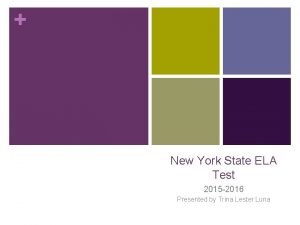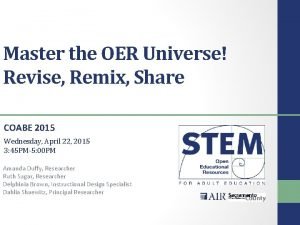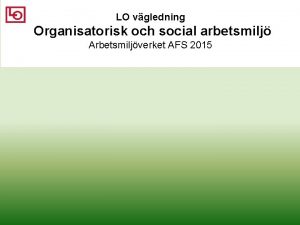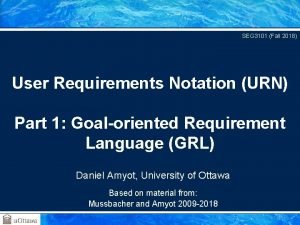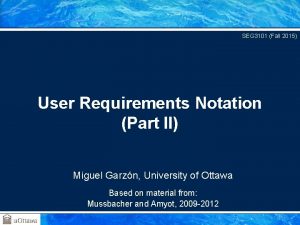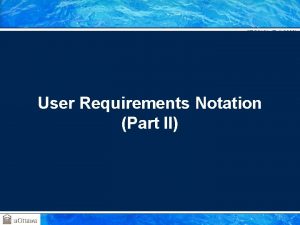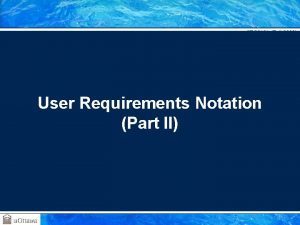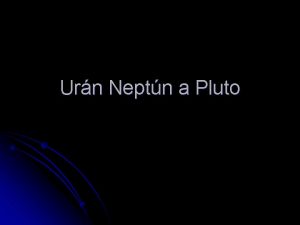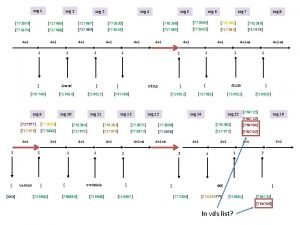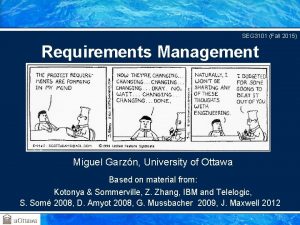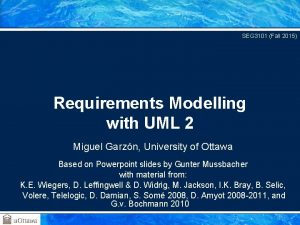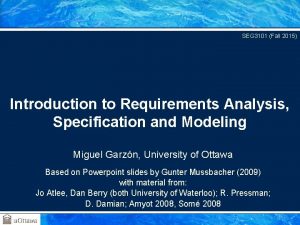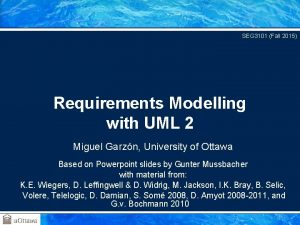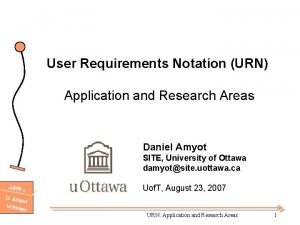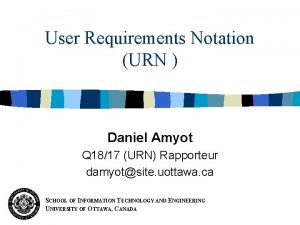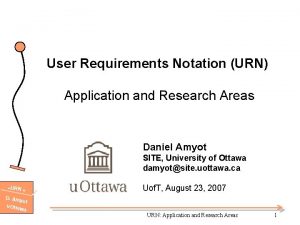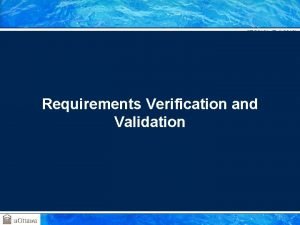SEG 3101 Fall 2015 User Requirements Notation URN













































































- Slides: 77

SEG 3101 (Fall 2015) User Requirements Notation (URN) Part 1: Goal-oriented Requirement Language (GRL) Miguel Garzón, University of Ottawa Based on material from: Mussbacher and Amyot 2009 -2014

Bird’s Eye View of URN GRL intentional elements + actors + UR N L links+ indicators + strategies ink s UCM responsibilities + causality + components + scenarios 2 SEG 3101 (Fall 2014). URN and GRL

Table of Contents • Introduction to the User Requirements Notation (URN) • Goals and Rationales • Goal-oriented Requirement Language (GRL) • GRL Basics • Evaluations • Examples • Tools • Indicators • All models are false, but some models are useful. 1 [1] George Edward Pelham Box (1919 -) 3 SEG 3101 (Fall 2014). URN and GRL

User Requirements Notation j. UCMNav Goals and Rationale GRL Basics Evaluations Examples Tools Indicators URN Overview (1) • URN is a semi-formal, lightweight graphical language for modeling and analyzing requirements in the form of goals and scenarios and the links between them • Combines two existing notations Commuter Minimize time lost by commute 50 Work during commute 80 • Goal-oriented Requirement Language (GRL) (based on i* & NFR Framework) Minimize travel time -40 -30 45 Take public transport -10 OR Regular Bus Minimize cost for commute 80 Take private transport OR Express Bus Take own car Hitch a ride 40 60 50 Minimize infrastructure cost 80 80 -90 Regular Bus Express Bus Share ongoing cost -20 20 -20 60 80 Take own car Hitch a ride Commuting home • Use Case Maps (UCMs) secure home ready to leave home stay home transport elevator take elevator commute Car drive car X Hitch a Ride transport Secure Home home elevator transport in cubicle Take Elevator call elevator X select floor X arm system in out 1 out 2 stay home take elevatorstairs X arrived • Support for the elicitation, analysis, hitch a ride in car X lock door X use alternative X alarm system Arm System home Regular Bus commuter deal with work email X take #95 take #96 X take #97 X X transport system notalarm armed [quit] acceptcheck code Xcode. X armed [matched] [not matched] Express Bus commuter transport deal with work email X specification, and validation of requirements • Allows systems, software, and requirements engineers to discover and specify requirements for a proposed system or an evolving system, and analyse such requirements for correctness and completeness take #100 X URN: www. usecasemaps. org/urn j. UCMNav: www. softwareengineering. ca/jucmnav Virtual Library: www. usecasemaps. org/pub SEG 3101 (Fall 2014). URN and GRL

User Requirements Notation j. UCMNav Goals and Rationale GRL Basics Evaluations Examples Tools Indicators URN Overview (2) • URN models can be used to specify and analyze various types of reactive systems, business processes, and telecommunications standards • j. UCMNav • URN editor & analysis tool • Eclipse plug-in • Open source project 5 SEG 3101 (Fall 2014). URN and GRL

User Requirements Notation j. UCMNav Goals and Rationale GRL Basics Evaluations Examples Tools Indicators URN Overview (3) vision GRL Model business goals, stakeholders’ priorities, alternative solutions, rationale, and decisions traceability with URN links extensible with metadata UCM Model & test use cases; investigate high level architecture; transform to more detailed models called strategies, compared with GRL evaluation mechanism with UCM traversal mechanism based on UCM scenario definitions more detailed models A GRL / UCM model visually communicates business objectives and constraints / high-level functional requirements to all stakeholders 6 SEG 3101 (Fall 2014). URN and GRL

User Requirements Notation j. UCMNav Goals and Rationale GRL Basics Evaluations Examples Tools Indicators ITU-T Z. 151: URN – Language Definition • URN is the first and currently only standard which explicitly addresses goals (non-functional requirements with GRL) in addition to scenarios (functional requirements with UCMs) in a graphical way in one unified language • International Telecommunication Union (ITU-T Z. 150 series) • ITU-T Z. 150 (02/03, revised 02/11): User Requirements Notation (URN) - Language requirements and framework • ITU-T Z. 151 (11/08, corrigendum 2011, revised 2012): User requirements notation (URN) - Language definition • Metamodel, abstract/concrete syntaxes, semantics… ITU-T Z. 150: http: //www. itu. int/rec/T-REC-Z. 150/en ITU-T Z. 151: http: //www. itu. int/rec/T-REC-Z. 151/en 7 SEG 3101 (Fall 2014). URN and GRL

User Requirements Notation j. UCMNav Goals and Rationale GRL Basics Evaluations Examples Tools Indicators About ITU-T • International Telecommunication Union • United Nations organization • 193 countries + hundreds of member companies • Free access to the definition of many standard languages • http: //www. itu. int/ITU-T/studygroups/com 17/index. html • Question 13 (Formal languages and telecommunication software) of Study Group 17 (Security) • Z. 15 x User Requirements Notation (URN) • Also SDL, MSC, and profiles • Other international bodies standardize languages • ANSI (C, C++), W 3 C (HTML, XML), IEEE (VHDL), ISO (LOTOS), OMG (UML), OASIS (XACML), etc. 8 SEG 3101 (Fall 2014). URN and GRL

User Requirements Notation j. UCMNav Goals and Rationale GRL Basics Evaluations Examples Tools Indicators ITU-T Languages • SDL: Specification and Description Language • For defining and executing complete reactive systems • MSC: Message Sequence Charts • For defining message-oriented scenarios • ASN. 1: Abstract Syntax Notation One • For defining data types/packets • TTCN-3: Testing and Test Control Notation • For defining test cases and test environments • URN: User Requirements Notation • Goal-oriented Requirements Language (GRL) • Use Case Map notation (UCM) • For defining abstract goals, scenarios, and requirements • UML 2. 0 profiles for some of these languages (e. g. , SDL)… 9 SEG 3101 (Fall 2014). URN and GRL

Goal-oriented Requirement Language (GRL)

User Requirements Notation j. UCMNav Goals and Rationale GRL Basics Evaluations Examples Tools Indicators What is a Rationale? • Rationale is the reasoning that leads to the system • Rationales include • Issues that were addressed • Alternatives that were considered • Decisions that were made to resolve the issues • Criteria that were used to guide decisions • Debate developers went through to reach a decision Source: Bruegge and Dutoit, chapter 12 11 SEG 3101 (Fall 2014). URN and GRL

User Requirements Notation j. UCMNav Goals and Rationale GRL Basics Evaluations Examples Tools Indicators Uses of Rationales in Software Engineering • Improve design support • Avoid duplicate evaluation of poor alternatives • Make consistent and explicit trade-offs • Improve documentation support • Makes it easier for non developers (e. g. , managers, lawyers, technical writers) to review the design • Improve maintenance support • Provide maintainers with design context • Improve learning • New staff can learn the design by replaying the decisions that produced it 12 SEG 3101 (Fall 2014). URN and GRL

User Requirements Notation j. UCMNav Goals and Rationale GRL Basics Evaluations Examples Tools Indicators ATM Example (Table) Question: Alternative Authentication Mechanisms? References: Service: Authenticate Decision: Smart Card + PIN Criteria 1: ATM Unit Cost Criteria 2: Privacy Option 1: Account number + – Option 2: Fingerprint reader – + Option 3: Smart Card + PIN + + Qualitative version 13 SEG 3101 (Fall 2014). URN and GRL

User Requirements Notation j. UCMNav Goals and Rationale GRL Basics Evaluations Examples Tools Indicators ATM Example (Table) Question: Alternative Authentication Mechanisms? References: Service: Authenticate Decision: Smart Card + PIN Criteria 1: ATM Unit Cost Criteria 2: Privacy Option 1: Account number 1 20 Option 2: Fingerprint reader 4 30 Option 3: Smart Card + PIN 2 40 Quantitative version Questions: Relationships between criteria? Scalability? Stakeholders? . . . Can we do better than a simple table? 14 SEG 3101 (Fall 2014). URN and GRL

User Requirements Notation j. UCMNav Goals and Rationale GRL Basics Evaluations Examples Tools Indicators What Is a Goal? • Goal: high level objective of the business, organization or system • A requirement specifies how a goal should be accomplished by a proposed system • Operationalization: the process of defining a goal with enough detail so that its sub-goals have an operational definition. • Decomposition: the process of subdividing a set of goals into a logical sub-grouping so that system requirements can be more easily understood, defined and specified. • Obstacles: behaviours or other goals that prevent or block the achievement of a given goal. • Abstracting and identifying goal obstacles allows one to consider the possible ways for goals to fail and anticipate exception cases. Source: A. Antón 15 SEG 3101 (Fall 2014). URN and GRL

User Requirements Notation j. UCMNav Goals and Rationale GRL Basics Evaluations Examples Tools Indicators Roles of Goals in RE [van Lamsveerde, 2009] • • • • Goal refinement provides a natural mechanism for structuring complex specifications at different levels of concern. Goals provide the rationale for requirements. Goals drive the identification of requirements to support them. Goals provide a richer structure for satisfaction arguments. Goals provide a basis for showing the alignment of the system-to-be with the organization’s strategic objectives. Goals provide a precise criterion for requirements completeness. Goals provide a precise criterion for requirements relevance. Goals provide a natural way of structuring the requirements domain. Goals provide anchors for risk analysis. Goals provide the roots for managing conflicts among requirements. Goals provide a criterion for delimiting the scope of the system. Goals support the analysis of dependencies among agents. Goals provide a basis for reasoning about alternative options. Goals support traceability management. Goals provide essential information for evolution support. 16 SEG 3101 (Fall 2014). URN and GRL

User Requirements Notation j. UCMNav Goals and Rationale GRL Basics Evaluations Examples Tools Indicators GRL Overview (1) • The Goal-oriented Requirement Language (GRL) • Graphical notation • Connects requirements to business objectives • Allows reasoning about (non-functional) requirements • Is based on i* (concepts / syntax) and the NFR Framework (evaluation mechanism) • Indicators, strategies, and extension mechanisms • GRL models the “why” aspect • Model goals and other intentional concepts • Little or no operational details • Supports goal and trade-off analysis and evaluations 17 SEG 3101 (Fall 2014). URN and GRL

User Requirements Notation j. UCMNav Goals and Rationale GRL Basics Evaluations Examples Tools Indicators GRL Overview (2) • GRL is used to … • Visually describe business goals, objectives, stakeholders’ priorities, alternative solutions, rationale, and decisions • Decompose high-level goals into alternative solutions called tasks (this process is called operationalization) • Model positive & negative influences of goals and tasks on each other • Capture dependencies between actors (i. e. , stakeholders) • Reason about alternatives and trade-offs 18 SEG 3101 (Fall 2014). URN and GRL

User Requirements Notation j. UCMNav Goals and Rationale GRL Basics Evaluations Examples Tools Indicators GRL Notation (1) GRL Example: Tiny Online Business Online Shopper Resource Business Owner Payment Increase Sales + Offer Online Shopping + Contribution Dependency Have System Security Actor Minimize Cost of Terminal _ + OR Use Fingerprint . + Access Authorization Use Password Ensure Authentication Use Cardkey Have Security of Host Have Security of Terminal Decomposition Biometrics is no regular, off-the-shelf technology Belief +. + Correlation Softgoal . + Encryption AND Task Provide Identification Goal 19 SEG 3101 (Fall 2014). URN and GRL

User Requirements Notation j. UCMNav Goals and Rationale GRL Basics Evaluations Examples Tools Indicators GRL Notation (2) • Intentional elements • Softgoal, task , resource, belief • Achievement of softgoal is qualifiable but not measurable; it is quantifiable for goals • Softgoal …often non-functional • Goal … often functional • Task is a proposed solution that achieves a goal or satisfies (satisfices) a softgoal • Belief captures rationale 20 SEG 3101 (Fall 2014). URN and GRL

User Requirements Notation j. UCMNav Goals and Rationale GRL Basics Evaluations Examples Tools Indicators GRL Notation (3) • Contribution and Correlation Links • Contribution describes desired impact, correlation shows side effects • Qualitative or quantitative contribution types are used for these links • Decomposition Link • Defines what an intentional element needs to be satisfied • AND • OR • XOR GRL Contributions Types: (qualitative) Break Make Some- Some+ Hurt Help ? Unknown • Dependency Link • An actor (the depender) depends on another actor (the dependee) for something (the dependum), e. g. the business owner depends on the online shopper for payment (the dependum is optional) 21 SEG 3101 (Fall 2014). URN and GRL

User Requirements Notation j. UCMNav Goals and Rationale GRL Basics Evaluations Examples Tools Indicators GRL Notation (4) • GRL graphs can be allocated to actors • Dependencies can be defined between actors together with intermediate resources or other elements • Provides a strategic view Note: this is an i* model and therefore the syntax is slightly different 22 SEG 3101 (Fall 2014). URN and GRL

User Requirements Notation j. UCMNav Goals and Rationale GRL Basics Evaluations Examples Tools Indicators Why GRL? • Goals become an important driver for requirements elaboration – yet, stakeholders goals and objectives are complex and will conflict… • GRL expresses and clarifies tentative, ill-defined, and ambiguous requirements • Supports argumentation, negotiation, conflict detection & resolution, and in general decisions • Captures decision rationale and criteria (documentation!) • GRL identifies alternative requirements and alternative system boundaries • GRL provides clear traceability from strategic objectives to technical requirements • GRL allows reuse of stable higher-level goals when the system evolves • Nothing like this in UML, Sys. ML or BPMN… 23 SEG 3101 (Fall 2014). URN and GRL

User Requirements Notation j. UCMNav Goals and Rationale GRL Basics Evaluations Examples Tools Indicators GRL – Strategy Execution (Strategy 1) GRL Example: Tiny Online Business * * 100 Online Shopper 25 42 Business Owner Payment 33 75 Cost of Terminal _ + 100 -75 Security of Host + Access Authorization OR * 0 Cardkey * 100 Encryption -75 * * 100 AND Authentication 100 +. . . Biometrics is no regular, off-the-shelf technology Password 25 Security of Terminal + Fingerprint 44 + + 0 high System Security Importance medium + Offer Online Shopping high Increase Sales Identification Initial Satisfaction Level 24 SEG 3101 (Fall 2014). URN and GRL

User Requirements Notation j. UCMNav Goals and Rationale GRL Basics Evaluations Examples Tools Indicators GRL – Strategies and Evaluation Mechanism (1) • GRL allows a particular configuration of intentional elements to be defined in a strategy (i. e. , one possible solution) • Captures the initial, user-defined satisfaction levels for these elements separately from the GRL graphs • Strategies can be compared with each other for trade-off analyses • In order to analyze the goal model and compare solutions with each other, j. UCMNav’s customizable evaluation mechanism executes the strategies • Propagating satisfaction levels to the other elements and to actors shows impact of proposed solution on high level goals for each stakeholder • Propagation starts at user-defined satisfaction levels of intentional elements (usually bottom-up) 25 SEG 3101 (Fall 2014). URN and GRL

User Requirements Notation j. UCMNav Goals and Rationale GRL Basics Evaluations Examples Tools Indicators GRL – Strategies and Evaluation Mechanism (2) • Evaluations of GRL graphs show the impact of qualitative decisions on high level softgoals • Evaluation mechanism takes into consideration • Initial satisfaction levels of children (intentional elements) • Links, types of these links, and contribution/decomposition types • Importance defined for intentional elements • More complete than simple pros/cons tables or criteria evaluation matrices • See Chapter 11. 1 and Appendix II of the Z. 151 standard • Standard provides minimum requirements 26 SEG 3101 (Fall 2014). URN and GRL

User Requirements Notation j. UCMNav Goals and Rationale GRL Basics Evaluations Examples Tools Indicators GRL – Qualitative or Quantitative Approach • Qualitative Approach • Contribution types: from Make to Break • Importance: High, Medium, Low, or None • Qualitative satisfaction levels • Quantitative Approach • Contribution types: [-100, 100] GRL Satisfaction Levels: (qualitative) Satisfied Weakly Satisfied Unknown • Importance: [0, 100] • Quantitative satisfaction levels: [-100, 100] Weakly Denied • Qualitative contribution types Denied • Hybrid Approach is also possible • Quantitative importance • Quantitative satisfaction levels Conflict None 27 SEG 3101 (Fall 2014). URN and GRL

User Requirements Notation j. UCMNav Goals and Rationale GRL Basics Evaluations Examples Tools Indicators GRL – Strategy Execution (Strategy 2) GRL Example: Tiny Online Business -34 * * 100 Online Shopper Business Owner Payment -17 + -75 -31 + -75 + 100 * 100 . . Biometrics is no regular, off-the-shelf technology +. Security of Host Security of Terminal + -75 + Access Authorization 0 Encryption AND Authentication OR * -75 * 0 100 Fingerprint high System Security Cost of Terminal _ + Offer Online Shopping high medium Increase Sales -23 Password 0 Identification Cardkey 28 SEG 3101 (Fall 2014). URN and GRL

User Requirements Notation j. UCMNav Goals and Rationale GRL Basics Evaluations Examples Tools Indicators GRL – Strategy Execution (Strategy 3) GRL Example: Tiny Online Business * * 100 Online Shopper 51 52 Business Owner Payment 68 medium 0 + 100 . . 100 Encryption AND Authentication OR 0 0 Password * 100 * + 0 Access Authorization Biometrics is no regular, off-the-shelf technology +. Security of Host Security of Terminal + Fingerprint 90 + + 0 high System Security Cost of Terminal _ + Offer Online Shopping high Increase Sales 0 Identification Cardkey 29 SEG 3101 (Fall 2014). URN and GRL

User Requirements Notation j. UCMNav Goals and Rationale GRL Basics Evaluations Examples Tools Indicators New [0. . 100] GRL Satisfaction Scale Right-click on URNspec (in the Outline view) to switch between [0. . 100] and [-100. . 100]. The menu for quantitative values will change too. New visualization option with [0. . 100] for evaluations Suddenly, 25 is no longer good (orange)! Applies to new models. A [0. . 100] satisfaction scale instead of a [-100. . 100] scale in GRL is more intuitive to some types of stakeholders (especially in combination with negative contributions…) 30 SEG 3101 (Fall 2014). URN and GRL

User Requirements Notation j. UCMNav Goals and Rationale GRL Basics Evaluations Examples Tools Indicators j. UCMNav 6 Tool, for Eclipse Perspectives Menu Editor Toolbar Projects & Files Views Palette Model Elements in File Analysis Details of Model Element 31 SEG 3101 (Fall 2014). URN and GRL

User Requirements Notation j. UCMNav Goals and Rationale GRL Basics Evaluations Examples Tools Indicators URN Abstract Metamodel 32 SEG 3101 (Fall 2014). URN and GRL

User Requirements Notation j. UCMNav Goals and Rationale GRL Basics Evaluations Examples Tools Indicators GRL Abstract Metamodel 33 SEG 3101 (Fall 2014). URN and GRL

User Requirements Notation j. UCMNav Goals and Rationale GRL Basics Evaluations Examples Tools Indicators GRL Strategies Abstract Metamodel 34 SEG 3101 (Fall 2014). URN and GRL

User Requirements Notation j. UCMNav Goals and Rationale GRL Basics Evaluations Examples Tools Indicators Strategies in j. UCMNav A star (*) indicates an initial value part of a given strategy (element also shown in dashed lines). All the others are evaluated through a propagation algorithm. Dashed red lines are overridden values (could be computed) 35 SEG 3101 (Fall 2014). URN and GRL

User Requirements Notation j. UCMNav Goals and Rationale GRL Basics Evaluations Examples Tools Indicators Propagation Algorithms in j. UCMNav • j. UCMNav supports 6 propagation algorithms • 1 Quantitative, 1 Qualitative • 1 Quantitative/Qualitative hybrid • Experimental support for indicator propagation • Experimental support for conditions (legal compliance) • Experimental support for constraint-based • Most support the automatic resolution of conflicts • Most use links in this order: • Decompositions • Contributions • Dependencies 36 SEG 3101 (Fall 2014). URN and GRL

User Requirements Notation j. UCMNav Goals and Rationale GRL Basics Evaluations Examples Tools Indicators Quant. Alg. – Decompositions and Contributions • Minimum for AND, maximum for OR • Contributions are additive but normalized and take a tolerance into account 37 SEG 3101 (Fall 2014). URN and GRL

User Requirements Notation j. UCMNav Goals and Rationale GRL Basics Evaluations Examples Tools Indicators Quantitative Algorithm – Dependencies and Actors • Depender’s satisfaction level is not more than the dependum’s (and the dependee’s) • Evaluations deal with negotiations between stakeholders • Actor evaluations help analyzing and comparing the satisfaction levels of each actor based on the selected strategy • Computed from importance attribute and satisfaction levels of intentional element references bound to actors 38 SEG 3101 (Fall 2014). URN and GRL

User Requirements Notation j. UCMNav Goals and Rationale GRL Basics Evaluations Examples Tools Indicators Qualitative Algorithm – AND Decomposition 39 SEG 3101 (Fall 2014). URN and GRL

User Requirements Notation j. UCMNav Goals and Rationale GRL Basics Evaluations Examples Tools Indicators Qualitative Algorithm – OR Decomposition 40 SEG 3101 (Fall 2014). URN and GRL

Computation of weighted contributions 41 SEG 3101 (Fall 2014). URN and GRL

User Requirements Notation j. UCMNav Goals and Rationale GRL Basics Evaluations Examples Tools Indicators Qualitative Algorithm – Contributions and Actors 42 SEG 3101 (Fall 2014). URN and GRL

Qualitative evaluation of actors 43 SEG 3101 (Fall 2014). URN and GRL

User Requirements Notation j. UCMNav Goals and Rationale GRL Basics Evaluations Examples Tools Indicators Qualitative Algorithm – Dependencies 44 SEG 3101 (Fall 2014). URN and GRL

User Requirements Notation j. UCMNav Goals and Rationale GRL Basics Evaluations Examples Tools Indicators Recurring Pattern in GRL 45 SEG 3101 (Fall 2014). URN and GRL

User Requirements Notation j. UCMNav Goals and Rationale GRL Basics Evaluations Examples Tools Indicators GRL Example I – Context • New service for wireless network • Where to put the service logic? • Where to put the service data? 46 SEG 3101 (Fall 2014). URN and GRL

User Requirements Notation j. UCMNav Goals and Rationale GRL Basics Evaluations Examples Tools Indicators GRL Example I – Intentional Elements and Actors 47 SEG 3101 (Fall 2014). URN and GRL

User Requirements Notation j. UCMNav Goals and Rationale GRL Basics Evaluations Examples Tools Indicators GRL Example I – Links 48 SEG 3101 (Fall 2014). URN and GRL

User Requirements Notation j. UCMNav Goals and Rationale GRL Basics Evaluations Examples Tools Indicators GRL Example I – Contribution Types Qualitative or quantitative 49 SEG 3101 (Fall 2014). URN and GRL

User Requirements Notation j. UCMNav Goals and Rationale GRL Basics Evaluations Examples Tools Indicators GRL Example I – Qualitative Model Evaluation 50 SEG 3101 (Fall 2014). URN and GRL

User Requirements Notation j. UCMNav Goals and Rationale GRL Basics Evaluations Examples Tools Indicators GRL Example I – Quantitative Model Evaluation 51 SEG 3101 (Fall 2014). URN and GRL

User Requirements Notation j. UCMNav Goals and Rationale GRL Basics Evaluations Examples Tools Indicators GRL Example II – Context • GRL model that addresses privacy protection in a hospital environment • Researchers want access to patient data but the Health Information Custodian (HIC – i. e. , the hospital) needs to protect patient privacy, as required by law (PHIPA in Ontario). • The process of accessing databases must ensure privacy. As required by law, a Research Ethics Board (REB) is usually involved in assessing privacy risks for the research protocol proposed by a researcher. • DB administrators also want to ensure that DB users are accountable for their acts. 52 SEG 3101 (Fall 2014). URN and GRL

User Requirements Notation j. UCMNav Goals and Rationale GRL Basics Evaluations Examples Tools Indicators GRL Example II – GRL Model 53 SEG 3101 (Fall 2014). URN and GRL

User Requirements Notation j. UCMNav Goals and Rationale GRL Basics Evaluations Examples Tools Indicators GRL Example II – One GRL Model, Many Diagrams 54 SEG 3101 (Fall 2014). URN and GRL

User Requirements Notation j. UCMNav Goals and Rationale GRL Basics Evaluations Examples Tools Indicators GRL Example II – Qualitative Model Evaluation 55 SEG 3101 (Fall 2014). URN and GRL

User Requirements Notation j. UCMNav Goals and Rationale GRL Basics Evaluations Examples Tools Indicators GRL Example II – Quantitative Model Evaluation • In addition to the qualitative approach, strategies and evaluations can also be quantitative ([-100, 100] scale) • Hybrid algorithms can also be defined 56 SEG 3101 (Fall 2014). URN and GRL

User Requirements Notation j. UCMNav Goals and Rationale GRL Basics Evaluations Examples Tools Indicators Tool Support – San. Dri. La (Plug-in for Visio) 57 SEG 3101 (Fall 2014). URN and GRL

User Requirements Notation j. UCMNav Goals and Rationale GRL Basics Evaluations Examples Tools Indicators Tool – Open. OME, with Eclipse Plug-in http: //www. cs. toronto. edu/km/openome/ 58 SEG 3101 (Fall 2014). URN and GRL

User Requirements Notation j. UCMNav Goals and Rationale GRL Basics Evaluations Examples Tools Indicators j. UCMNav (Eclipse Plug-in) • Features for GRL • 6 GRL evaluation algorithms, with color highlight • One model, multiple diagrams • References to actors and intentional elements • Drag&drop from outline or via properties • Auto-layout • Catalogues • For exporting/importing/reusing common models Toolbar Editor Navigator view • Export graphics (. bmp, . gif, . jpg) • Export strategy evaluations (. csv) Outline view • URN links (for integration with UCMs) • Export to DOORS Palette Properties view Scenarios and Strategies view 59 SEG 3101 (Fall 2014). URN and GRL

User Requirements Notation j. UCMNav Goals and Rationale GRL Basics Evaluations Examples Tools Indicators Inclusion of Measures in Goal Models • GRL includes a notion of goal satisfaction, with qualitative and quantitative ([-100. . 100], and now [0. . 100]) scales. • However, there is often a need to better relate observations about the real world to the goal model, with domain-specific units such as: • Currencies (e. g. , revenues in $) • Durations (e. g. , waiting time in a hospital, in hours) • Counts (e. g. , number of new students admitted in SEG) • GRL supports this kind of information, and integrates it in the rest of the goal model • Key Performance Indicator (KPI) Average Work Time (in min) • KPIs help measure goals and NFRs with quantifiable metrics • GRL KPIs can also be fed from external sources of information, hence turning the GRL model into a monitoring engine (e. g. , a dashboard). 60 SEG 3101 (Fall 2014). URN and GRL

User Requirements Notation j. UCMNav Goals and Rationale GRL Basics Evaluations Examples Tools Indicators GRL Key Performance Indicators • In GRL, a KPI is defined as an intentional element, but with additional characteristics • Attributes (for a given GRL strategy) • An evaluation value (observed, or simulated in a what-if strategy) • A target value (the KPI is fully satisfied if the evaluation value reaches it) • A worst-case value (the KPI is fully denied if the evaluation value reaches it) • A threshold value (the KPI is neutral if the evaluation value equals it) • A unit (e. g. , $) • Associations (for a given GRL model) • Can be part of contributions or decompositions 61 SEG 3101 (Fall 2014). URN and GRL

62 SEG 3101 (Fall 2014). URN and GRL

User Requirements Notation j. UCMNav Goals and Rationale GRL Basics Evaluations Examples Tools Indicators: From Current to Satisfaction Value Principals $1300 ? ? ? Staffing cost Increased profits 50 Attribute Value GRL Satisfaction Target $1000 100 Threshold $1500 0 Worst-case $2500 -100 Current $1300 ? ? ? 63 SEG 3101 (Fall 2014). URN and GRL

User Requirements Notation j. UCMNav Goals and Rationale GRL Basics Evaluations Examples Tools Indicators: From Current to Satisfaction Value Principals $1300 40(*) 20 Staffing cost Increased profits 50 Attribute Value GRL Satisfaction Target $1000 100 Threshold $1500 0 Worst-case $2500 -100 Current $1300 40 64 SEG 3101 (Fall 2014). URN and GRL

User Requirements Notation j. UCMNav Goals and Rationale GRL Basics Evaluations Examples Tools Indicators From KPIs to GRL Satisfaction Levels Note: Linear interpolation is currently being used to compute the satisfaction, which is a function of the evaluation, target, threshold, and worst values. 65 SEG 3101 (Fall 2014). URN and GRL

User Requirements Notation j. UCMNav Goals and Rationale GRL Basics Evaluations Examples Tools Indicators Evaluations Involving KPIs • KPIs can contribute to goals in GRL • KPIs can be fed by external sources • KPIs can be linked to scenarios 66 SEG 3101 (Fall 2014). URN and GRL

User Requirements Notation j. UCMNav Goals and Rationale GRL Basics Evaluations Examples Tools Indicators Multiple Views Process Model Performance Model Goal Model 67 SEG 3101 (Fall 2014). URN and GRL

j. UCMNav Extensions for KPI and Monitoring Business Process Compliance with URNp. 68 SEG 3101 (Fall 2014). URN and GRL

User Requirements Notation j. UCMNav Goals and Rationale GRL Basics Evaluations Examples Tools Indicators KPIs: Commuting Example (from G. Mussbacher) Example: Commuting Minimize time lost by commute 40 50 Work during commute 10080 50 60 Minimize travel time -10 100 45 Minimize infrastructure cost -30 -40 80 100 Monthly Infrastructure Cost (in $) OR Take public transport Take private transport 100 Regular Bus Average Ongoing Cost (in $) OR OR Key Performance Indicator (KPI) Share ongoing cost Commuting Average Travel Time (in min) Average Work Time (in min) Commuter Minimize cost for commute Express Bus Take own car Hitch a ride 69 SEG 3101 (Fall 2014). URN and GRL

User Requirements Notation j. UCMNav Goals and Rationale GRL Basics Evaluations Examples Tools Indicators From Real World Values to Model Values Real World Value Model Value (Satisfaction Value) Average Work Time (in min) 45 -10 56 52 24 24 -40 -30 80 80 10 10 455 140 80 80 -90 -20 68 76 120 92 80 60 -20 20 80 4. 5 Target Value (60) Threshold Value (100) Worst Value (200) 4. 5 Average Ongoing Cost (in $) 29. 75 Target Value (0) Threshold Value (50) Worst Value (500) 49 Monthly Infrastructure Cost (in $) Hitch a ride Target Value (20) Threshold Value (40) Worst Value (80) Take own car Average Travel Time (in min) Express Bus Target Value (60) Threshold Value (5) Worst Value (0) Regular Bus 70 SEG 3101 (Fall 2014). URN and GRL

User Requirements Notation j. UCMNav Goals and Rationale GRL Basics Evaluations Examples Tools Indicators Strategy Execution with KPIs (1/2) Example: Commuting Strategy “Regular Bus”: Regular Bus = 100 40 80 20 Minimize time lost by by commute (100) Commuter Minimize cost forfor commute (50) 40 50 50 60 -40 80 Work during commute 80 80 Minimize travel time Minimize infrastructure cost Share ongoing cost 100 80* -40* 0 Take public transport KPI “Regular Bus”: Av. Work Time = 49 80 Av. Travel Time = 56 -40 Mo. Infrast. Cost = 10 80 Av. Ongoing Cost = 68 80 Monthly Infrastructure Cost (in $) OR 100 Take private transport Regular Bus 80* Average Ongoing Cost (in $) OR OR 100* 100 80* Commuting Average Travel Time (in min) Average Work Time (in min) 100 0 Express Bus 0 Take own car 0 Hitch a ride 71 SEG 3101 (Fall 2014). URN and GRL

User Requirements Notation j. UCMNav Goals and Rationale GRL Basics Evaluations Examples Tools Indicators Strategy Execution with KPIs (2/2) Example: Commuting Strategy “Hitch a ride”: Hitch a ride = 100 22 -4 35 Minimize time lost by by commute (100) Commuter Minimize cost forfor commute (50) 40 50 50 60 80 -10 Work during commute 20 -20 Minimize travel time Minimize infrastructure cost Share ongoing cost 100 -10* 80* 100 Take public transport KPI “Hitch a ride”: Av. Work Time = 4. 5 -10 Av. Travel Time = 24 80 Mo. Infrast. Cost = 140 -20 Av. Ongoing Cost = 92 20 Monthly Infrastructure Cost (in $) OR 0 Take private transport Regular Bus 20* Average Ongoing Cost (in $) OR OR 0 100 -20* Commuting Average Travel Time (in min) Average Work Time (in min) 100 0 Express Bus 0 Take own car 100* Hitch a ride 72 SEG 3101 (Fall 2014). URN and GRL

User Requirements Notation j. UCMNav Goals and Rationale GRL Basics Evaluations Examples Tools Indicators KPI Aggregation In j. UCMNav, KPI values can also be computed (aggregated) from other KPIs, in a way similar to Excel. Formula-based GRL evaluation algorithm p. 73 SEG 3101 (Fall 2014). URN and GRL

User Requirements Notation j. UCMNav Goals and Rationale GRL Basics Evaluations Examples Tools Indicators Other Goal-Oriented Languages • NFR Framework (Mylopoulos et al. ) • i* Framework (Yu et al. ) • KAOS -- Keep All Objectives Satisfied (van Lamsweerde et al. ) • GBRAM -- Goal-Based Requirements Analysis Method (Antón et al. ) • Tropos (Fuxman, Giorgini , Mylopoulos et al. ) • SMILE -- Structural Modeling, Inference, and Learning Engine and Ge. Nie (Druzdzel et al. ) • GRL is the first to be standardized • Overview: http: //www. cs. utoronto. ca/~alexei/pub/Lapouchnian. Depth. pdf • Tools: http: //istarwiki. org (i* Wiki) 74 SEG 3101 (Fall 2014). URN and GRL

User Requirements Notation j. UCMNav Goals and Rationale GRL Basics Evaluations Examples Tools Indicators Dilbert on Goals 75 SEG 3101 (Fall 2014). URN and GRL

Concrete GRL Metamodel (for Diagrams) 76 SEG 3101 (Fall 2014). URN and GRL

Appendix: GRL Notation Goal Softgoal Task Resource Denied Weakly Satisfied + Belief Conflict Indicator Actor with Boundary Collapsed Actor Unknown None Exceeds (c) GRL Satisfaction Levels (a) GRL Elements Contribution Dependency Correlation Decomposition Means-End (b) GRL Links Make Help Some Positive Some Negative Break Unknown Hurt (d) GRL Contributions Types 77 SEG 3101 (Fall 2014). URN and GRL
 Validation types
Validation types Seg 3101
Seg 3101 Iso iec ieee 29148 template
Iso iec ieee 29148 template Daniel amyot
Daniel amyot Seg 3101
Seg 3101 Seg 3101
Seg 3101 User requirements notation
User requirements notation Hardware 1990 cda
Hardware 1990 cda Cda 3101
Cda 3101 Cda 3101
Cda 3101 Jeff edmonds
Jeff edmonds Cda 3101
Cda 3101 Sample space of a 6 sided die
Sample space of a 6 sided die Article 15
Article 15 Pms complex mk
Pms complex mk Ode on a grecian urn literary devices
Ode on a grecian urn literary devices International arrival urn
International arrival urn Ode to the west wind quiz
Ode to the west wind quiz Ode on a grecian urn paraphrase
Ode on a grecian urn paraphrase Ode on a grecian urn summary
Ode on a grecian urn summary On the grasshopper and the cricket literary devices
On the grasshopper and the cricket literary devices Urn a contains 2 red and 3 blue marbles
Urn a contains 2 red and 3 blue marbles Seg library
Seg library Hvordan bakterier formerer seg
Hvordan bakterier formerer seg Indicadoreseducativos.seg.guanajuato.gob.mx
Indicadoreseducativos.seg.guanajuato.gob.mx Seg el
Seg el Sieg seg guanajuato gob mx calificaciones
Sieg seg guanajuato gob mx calificaciones Seam seg
Seam seg Seg ter qua
Seg ter qua 1 seg factories
1 seg factories Seg
Seg 40000x10000
40000x10000 Jordskorpeplater beveger seg
Jordskorpeplater beveger seg Uottawa seg course sequence
Uottawa seg course sequence Palabras que terminen con seg
Palabras que terminen con seg Single user and multi user operating system
Single user and multi user operating system Operating systems
Operating systems User action notation
User action notation User support
User support Comp 201
Comp 201 User requirement
User requirement User support requirements
User support requirements End user requirements
End user requirements How to write business requirements example
How to write business requirements example User requirements are expressed as in extreme programming
User requirements are expressed as in extreme programming Engineering notation symbols
Engineering notation symbols Postfix to infix conversion
Postfix to infix conversion Polish notation expression
Polish notation expression Infix to prefix
Infix to prefix Iso 9001:2015 awareness training ppt
Iso 9001:2015 awareness training ppt Whmis categories 1-4
Whmis categories 1-4 Two main whmis 2015 hazard groups are
Two main whmis 2015 hazard groups are Saasta astro quiz 2017 round 2 questions and answers
Saasta astro quiz 2017 round 2 questions and answers Astroquiz
Astroquiz Begin schooljaar 2015
Begin schooljaar 2015 Teacher twins@2015
Teacher twins@2015 State government entities certified agreement 2019
State government entities certified agreement 2019 Taxwise online training
Taxwise online training Drrm school hazard map
Drrm school hazard map Start schooljaar 2015
Start schooljaar 2015 Sni 3554 tahun 2015
Sni 3554 tahun 2015 Dpr 80/2013 sintesi
Dpr 80/2013 sintesi Code of practice 2015
Code of practice 2015 5406
5406 Quickbooks 2015: a complete course
Quickbooks 2015: a complete course Major changes in iso 9001 for 2015
Major changes in iso 9001 for 2015 Fph curriculum 2015
Fph curriculum 2015 Teacher twins 2014
Teacher twins 2014 Usps prices 2015
Usps prices 2015 Copyright 2015 all rights reserved
Copyright 2015 all rights reserved Gred spm 2015
Gred spm 2015 Perkalan 26 tahun 2015
Perkalan 26 tahun 2015 Nys ela test 2016
Nys ela test 2016 Dementia 2015
Dementia 2015 Coabe 2015
Coabe 2015 Manual de iglesia 2015
Manual de iglesia 2015 Arbetsmiljverket
Arbetsmiljverket Led conference 2015
Led conference 2015

